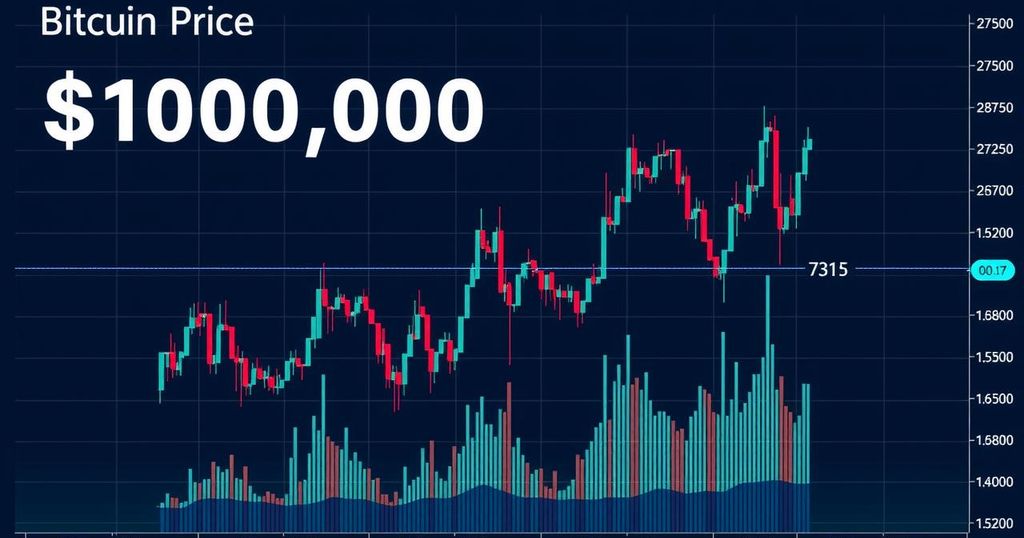Bitcoin Price Hovers at $101,000: Can It Reclaim $108,135 All-Time High?
In January 2025, Bitcoin has risen above $100,000, peaking at $101,192 following market volatility. Significant institutional interest, particularly from MicroStrategy and KULR, has contributed to this recovery. Despite optimism, Bitcoin remains short of its all-time high of $108,135, navigating a complex landscape influenced by macroeconomic conditions and regulatory developments. Analysts anticipate gradual gains, underscoring Bitcoin’s role as a hedge against economic uncertainty.
In early 2025, Bitcoin has intrigued investors by surpassing the $100,000 threshold, peaking at $101,192 following a challenging period of volatility. The digital currency’s recent price surge signals increased optimism, although it still remains below its previous all-time high of $108,135. This fluctuation has been driven by a confluence of factors including renewed institutional interest, macroeconomic influences, and ongoing geopolitical developments.
Recent market activity has been substantial, shaped largely by the Federal Reserve’s monetary policy changes. A notable decline of 5.6% occurred on December 18, 2024, bringing Bitcoin’s price down to approximately $95,000 due to market reactions to the Fed’s decisions. However, the cryptocurrency’s recovery in January has been substantial, fueled by institutional buying and a rise in market confidence.
Institutions have played a pivotal role in Bitcoin’s price stabilization, with prominent entities such as MicroStrategy and KULR Technology Group making significant acquisitions. MicroStrategy acquired 1,020 BTC, while KULR invested $21 million in Bitcoin. The inflow into Bitcoin-focused exchange-traded funds (ETFs) further reflects growing acceptance among institutional investors, with inflows reaching $908 million in December 2024 alone.
Macroeconomic factors continue to influence Bitcoin’s price trajectory. The Federal Reserve’s strategy to postpone interest rate cuts may serve as a double-edged sword, contributing to initial sell-offs but potentially providing future upward momentum as policies become more accommodative. Additionally, geopolitical elements, notably the potential establishment of a Bitcoin reserve proposed by President-elect Donald Trump, introduce further market dynamics.
The rising interest from institutions is notable, with firms such as Metaplanet Inc. planning to enhance their Bitcoin holdings significantly. These strategies indicate an increasing recognition of Bitcoin as a valuable asset, particularly in the context of inflation and economic uncertainty. The technical analysis presents a mixed outlook, identifying support levels at $98,000 and $95,000, along with immediate resistance around $101,500, where a breakthrough could lead toward the previous all-time high.
Market sentiment appears cautious yet optimistic. Although recent price movements have been driven mainly by spot purchases rather than leverage, limiting volatility risks, analysts predict that this environment might pave the way for future price increases. However, regulatory clarity remains a crucial factor for Bitcoin’s sustained growth, as potential regulatory shifts could pose risks to market stability.
Globally, Bitcoin continues to gain traction, with its adoption expanding in nations such as El Salvador and the Central African Republic, where it is recognized as legal tender. Furthermore, significant growth in Asia, particularly in Japan and South Korea, underscores Bitcoin’s evolution within the digital economy.
Despite its resilience, Bitcoin faces notable challenges including regulatory risks, macroeconomic uncertainties, and technological competition. Addressing these challenges is crucial for Bitcoin to maintain its stature as the preeminent cryptocurrency in a competitive landscape.
Bitcoin’s price dynamics are influenced by a variety of factors including institutional interest, regulatory changes, and macroeconomic trends. The cryptocurrency market has demonstrated volatility, often in response to government policies and global events. As institutional investments have surged, Bitcoin’s status as a potential hedge against inflation has only strengthened, leading to increasing mainstream acceptance. The interplay of these forces shapes investor sentiment and market behavior, making Bitcoin a focal point in financial discussions.
In summary, Bitcoin’s current price movements and market dynamics reflect a complex interplay of institutional interest, macroeconomic factors, and geopolitical developments. While it has achieved significant gains by crossing the $100,000 mark, the pathway to reclaiming its all-time high of $108,135 remains fraught with challenges and opportunities alike. Continued institutional adoption, along with regulatory clarity, may provide necessary support for future growth as Bitcoin solidifies its position in the global financial landscape.
Original Source: www.analyticsinsight.net








Post Comment